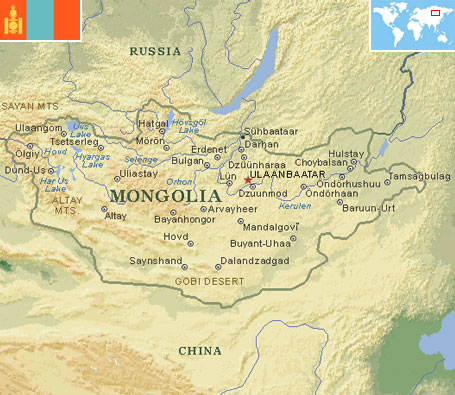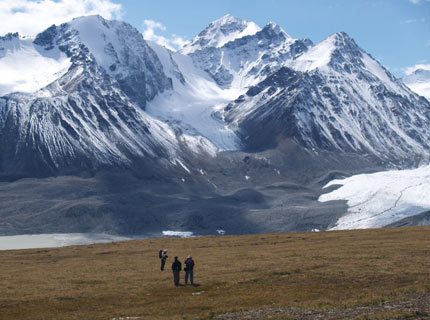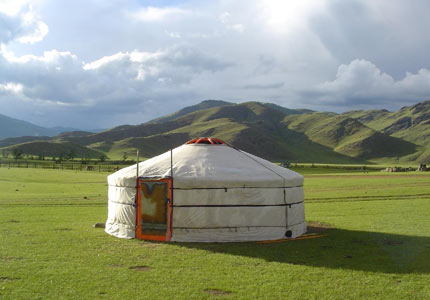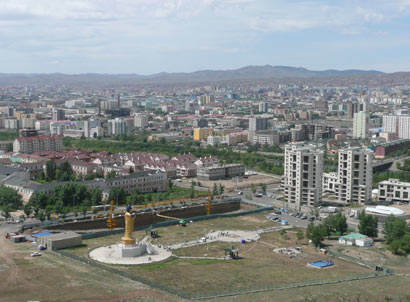Mongolia
Country statistics

Total area: 604,247 sq miles (1,565,000 sq km)
Population (2010 est.): 3,086,918 (growth rate: 1.4%); birth rate: 21.0/1000; infant mortality rate: 38.5/1000; life expectancy: 67.9; density per sq km: 1
Capital City: Ulaan Baatar
Monetary unit: Tugrik
Languages: Mongolian, 90%; also Turkic and Russian (1999)
Ethnicity/race: Mongol (predominantly Khalkha) 94.9%, Turkic (of which Kazak is the largest group) 5%, other (including Chinese and Russian) 0.1% (2000)
Religions: Buddhist Lamaist 50%, Islam 4%, Shamanism and Christian 4%, none 40% (2004)
Country introduction

Mongolia is a landlocked country in Northern Asia, located between China and Russia.
The terrain is one of mountains and rolling plateaus, with a high degree of relief. Overall, the land slopes from the high Altai Mountains of the west and the north to plains and depressions in the east and the south. The Hüiten Peak in extreme Western Mongolia on the Chinese border is the highest point at 4,374 m (14,350 ft). The lowest is 518 m (1,699 ft), an otherwise undistinguished spot in the Eastern Mongolian plain. The country has an average elevation of 1,580 m (5,183 ft).
Across the eastern part of the country stretches the vast grasslands of the Asian steppe. The steppe gradually fades into the Gobi desert, which extends throughout Southern Mongolia from the east to west. The Gobi is mostly rocky dirt and silt dotted with gravel, but also contains sand dunes in the drier areas near the southern border.
The country Is dotted with hundreds of lakes, the largest being Uvs-Nuur covering an area of 3,350 sq km (2,081 sq miles), Huvsgul coevring 2,620 sq km (1,627 sq miles) and Khar Us-Nuur covering 1,852 sq km (1,150 sq miles). The Orkhon (1,124 km / 698 miles), the Kherlen (1090 km / 677 miles) and the Selenge (539 km / 334 miles) are the largest rivers. The landscape also includes marshes, sand dunes, rolling grasslands, alpine forests, and permanent mountain glaciers.
Northern and Western Mongolia are seismically active zones, with frequent earthquakes and many hot springs and extinct volcanoes.
The culture

The Mongolian way of life is nomadic and intimately connected with the ways of animals. Despite urbanisation, the traditions of the steppes live on. Even in the cities, most Mongolians continue to live in a ger, a large, white felt tent that can be moved easily and has a universal layout: the door always faces south; towards the back and a little to the west is the place of honour set aside for guests; the back of the ger, the khoimor, is the place for elders and most treasured possessions; and on the back wall is the family altar, with Buddhist images, family photos and suitcases.
Mongolians have always taken wholeheartedly to Tibetan Buddhism and the links between Mongolia and Tibet are old and deep. Once in a lifetime, every devout Buddhist Mongolian tries to reach the holy city of Lhasa; the Tibetans in turn have relied on various Mongolian tribes to sustain their power. In Mongolia at the time of the communist takeover in 1921, there were 110,000 lamas (monks) living in about 700 monasteries.
Beginning in the 1930s, thousands of monks were arrested, sent to Siberian labour camps and never heard from again. Monasteries were closed and ransacked and all religious worship and ceremonies outlawed. Not until 1990 was freedom of religion restored. Since then, there's been a phenomenal revival of Buddhism (and other religions). Monasteries have reopened, and even some ex-Communist Party officials have become lamas. Monasteries and temples (süm) always have Tibetan names. There's a significant minority of Sunni Muslims in the far western regions of Mongolia, most of whom are ethnic Kazaks.
Mongolia's paintings, music and literature are dominated by Tibetan Buddhism and nomadism. Tsam dances are performed to exorcise evil spirits and are influenced by nomadism and Shamanism. Outlawed during communism, they're beginning to be performed again.
Traditional music involves a wide range of instruments and singing styles. In Mongolian khoomi singing, carefully trained male voices produce harmonic overtones from deep in the throat, releasing several notes at once. Traditional music and dance performances aren't complete without a touch of contortionism, an ancient Mongolian tradition.
Attractions & landmarks

Outside of the Ulan Bator, Mongolia's capital conditions are wild and largely uninhabited. Widely regarded as the coldest capital city in the world, Ulan Bator is over 360 years old and was founded in 1639 as 'Urga' by Bogd Zanabazar, the first Mongol spiritual leader. Since the 1960s, however, Ulan Bator has become dominated by Soviet style buildings and is today home to over a million inhabitants. Despite being heavily populated and surrounded by bleak suburbia though, Ulan Bator is situated along the banks of the Tuul river and backed by a beautiful mountain range. As a result, it is a truly fascinating city to visit.
Surrounding Ulan Bator are four mountains known as the four holy peaks. Known as Named Tsetseegum, Chingeltei, Songino Khairkhan and Bayansurkh, the peaks roughly correspond to the four points on a compass and offer the visitor spectacular views, woodland walks and a wide variety of bird, plant and animal life.
Over in the east of Mongolia stands Shiliin Bogd, an extinct volcano that at 1,778 m (5,833 ft) high is a sacred peak to natives. The mountain can be reached by Jeep and offers splendid walks and views ranging to the Chinese border.
Mongolia is perhaps best known for the Gobi desert, the coldest desert in the world. The desert consists of gravel-like sands and conjures images of camels and galloping wild horses. The best time to visit the desert is in June or September when the temperatures are neither freezing nor blisteringly hot, although it is advised that backpackers do not attempt a trek in the desert without an experienced guide.
Separated from China by a range of snowcapped peaks, the Tavanbogd National Park has a wealth of natural attractions. The park has three lakes which offer beautiful lakeside walks and visitors can also take a raft trip down the Dayn Nurr river.
Built by the Manchurian emperor Kansu in 1737, Amarbayasgalant Khiid is considered to be one of Mongolia's most beautiful and important Buddhist monasteries. In the 1930s, the monastery met opposition from the communists and ten of its thirty seven temples were destroyed. Today, the monastery is inhabited by 30 practising monks and visitors are welcome to watch the monks conduct their daily routines.